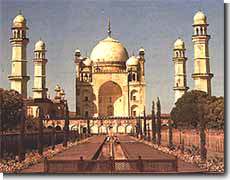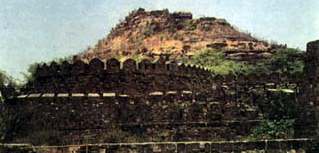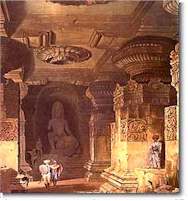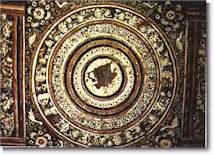India > Forts & Monuments > Maharashtra
MAHARASHTRA
Gate Way of India, Mumbai

Built to commemorate the visit of the first ever British Monarch, King George V and Queen Mary in 1911, was a white plaster arch, which was later changed to the carved yellow basalt Gateway. The Gateway was built by the architect George Wittet. The statues of patriot Shivaji and Swami Vivekananda on the square, before the Gateway, enhances the scene.
This city is one of the four Metropolitan cities of India. It is the Business Centre of India. All types of accommodation is available to suit best your requirements. It is accessible by Air, Rail, Road and Sea.
Bibi Ka Maqbara, Aurangabad

Bibi Ka Maqbara is the tomb of Begum Rabia Durani, wife of Emperor Aurangazeb. The monument is an excellent example of Persian architecture. The arched aclove surmounted by a swelling dome, the idea had acquired its own reputation in India. Bibi Ka Maqbara is considered to be a poor imitation of Taj Mahal in Agra. The Layout and surrounding of the tomb is very much similar to that of Taj but some how the architecture fails to produce the magic of Taj. Nevertheless, the monument has its own charm and has been attracting tourist far & wide. The MTDC organises a fair every October as the Bibi Ka Maqbara festival.
Fort of Daulatabad, Aurangabad

With palaces and pavilions crowning the massive granite outcrop, the medieval fortress of Daulatabad girdled by six kilometers of black crumbling walls, meets the eye like a mirage, shimmering in the torrid heat; haunting the memory of centuries gone by.
But it was Aurangzeb as Viceroy of the Deccan who decided to shift his capital from Daulatabad to Aurangabad. Soon the ancient city lost its importance.
Lying 15 km from Aurangabad in Maharashtra, ancient Devagiri or Daulatabad was a flourishing city 800 years ago, founded by Bhillamraja of the Yadava dynasty in 1187 AD. Less than 150 years later, the citadel enjoyed a brief glory of becoming the capital of India under Sultan Muhammad-bin-Tughlak who changed its name from Devagiri to Daulatabad.
All kinds of accommodation is available. Can be approached by Air, Rail and Road.
Ellora Temple & Caves

34 temples carved out of stones, 34 sculptured caves expressing Hindu, Buddhist and Jain themes, 34 priceless pages out of history. It took over five centuries for the Hindu, Buddhist and Jain monks to chisel out these monasteries, temples, chapels and decorate them with remarkable imagination and detail. These caves run North-South and take on the Golden radiance of the late afternoon sun.
The Buddhist expression - These sixteen caves are the oldest in the group and were carved in the 5th century. As one enters these caves, one crosses graceful angles and steps in a high ceilinged chamber where a 15 feet huge statue of Buddha is sitting in a preaching pose. In these caves the artist has tried an element of surprise by giving them expression of wood. Most of these 16 caves are viharas but cave number 10 is a chaitya. The style of carvings and sculplures in these caves indicate that initially the artist was going in for a simple decorations but later as in caves 11 and 12 he became more ambitious. The 10th cave has a impression of wooden beams on its ceiling and has a small decorated window which illuminates the sitting Buddha. These caves are rightly called the Vishvakarma caves. This cave is considered to be one of the finest in India. Here life and religion go hand in hand. The amorous couples play joyfully along the balustrade. Step out of this cave and you come across an upper gallery giving a view of the precisely carved Naga Queen, the harbinger of monsoon and the dwarfs who were the court entertainers. The Buddhists believe that Buddha returns after every five thousand years, thus the 12th cave has seven images of Budhha depicting his seven incarnations.
The Hindu Expression - The Hindu caves exhibit a totally different league from the Jain and Buddhist temples in terms of style, creative vision and execution skills. These temples were built top to bottom and the architecture of these caves show that it required several generation of planning and cordination to give it the final shape. Cave 14 was initially a Buddh Vihar but in 7th centutry it was dedicated as Shiva temple. Here Shiva is depicted as The destroyer. The 16 cave in the group is one of the audacious feat in architecture ever achieved. The idea was to build Mt. Kailash from a single stone. Hence the name Kailasnath temple. The artist then tried to give the structure shape of a temple. The scale at which the work was undertaken is enormous. It covers twice the area of the Parthenon in Athens and is 11/2 times high, and it entailed removing 200,000 tonnes of rock. It took 100 years to be completed. The Ramesvara cave has figurines of river Goddesses adorning its entrance. The Dumar Lena cave resembles the great cave shrine at Elephanta and is dedicated to lord Shiva.
The Jain Dedication - Each of the caves show the beliefs of the Jains, and their strict ascetism that embibed in them a spirit of non-violence towards all. These caves do not carry the high voltage drama of the Hindu or the Buddhist caves nor are they ambitious in size but they balance these with their exceptionally detailed work. The 32nd cave is a beautiful shrine with exquisite carvings of a lotus flower on the ceiling and an imposing Yakshi seated on her lion under a mango-tree laden with fruit. The ceiling of this double-storied cave are also decorated with paintings.
Ajanta Caves

When the echo of the chisel faded, the world forgot these cave temples. Till the 19th century these caves were hidden under thick forest growth. These caves are representation of Buddhist thoughts which were etched on walls of these caves. These caves were built between 2nd century BC to 7th century AD. The 30 chaityas and viharas have paintings which illustrate the life and incarnations of Buddha. The artist has lent his creativity in each work with an overwhelming sense of vitality. These paintings have survived time and till date the numerous paintings glowing on the walls leaves visitors spell bound. The contours of these figures and positions of their hands the make atmosphere very vibrant and alive. Ajanta caves were meant to provide seclusion to the Buddhist monks and their hammer & chisel offered a rich tapestry of images that speak of places, royalty, culture and tales of everyday life of ancient India.
The artists' skill and creativity were contemplated by his keen sense of observation. Many of the panels of the caves hold depiction of the Jatakas and numerous images of Buddha, Nymphs and Princesses. The flying Apsara in cave 17, the preaching Buddha in cave 16 to the sculptured Nagaraja in a sitting posture with his consort and a female attendant are to name few of the popular caves. Some of these enigmatic caves are illuminated by the natural light at a particular time of the day.
Ajanta also forms the base of a motif which was frequently used in the paintings, even in the 19th century Rajput miniature paintings. The motif of two lovers, a mithuna couple has been used in many of Ajanta paintings. One can spend days exploring, discovering and learning these caves but still the urge to see more hangs in the mind. The caves are so fascinating that one feels like coming here again and again.

